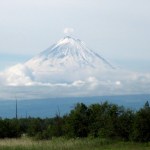Popocatépetl
On advice of Eruptions reader Ekoh, I thought it would be fun to try to come up with a list of the most tongue-twisting and bizarre volcano names out there. I know there are a few out there that I've only typed once (the rest of the time I cut-and-paste), so lets review some recent fun ones:
Eyjafjallajökull (Iceland) - everyone's favorite tongue twister.
Eyjafjallajökull erupting in mid-May, 2010.
And people are still talking about the how the ash crisis was handled.
Kliuchevskoi (Russia) - It doesn't help that it has like ten names to boot (from the Smithsonian GVP):
KAMCHATSKAIA GORA…
The latest update from the Smithsonian/USGS Global Volcanism Program!
Highlights (not including Taal, Eyjafjallajökull and Bezymianny) include:
Another thermal anomaly was spotted on an Kuril Island volcano - this one being Tiatia. The volcano has no seismic monitoring network, so the thermal anomaly is all that has been observed.
Lava flows and strombolian explosions continue at Guatemala's Pacaya. Some of the explosions have launched bombs hundreds of meters into the air.
Kliuchevskoi was another busy Russian volcano, with a large thermal anomaly and ash explosions that produced a plume…
Time to play a little catch up ...
Eyjafjallajökull erupting in early May. Image by and courtesy of Martin Rietze.
A brief update on our friend Eyjafjallajökull - the eruption plume from the volcano was considerably taller yesterday, reaching 6-9 km (20,000-30,000 feet), but prevailing winds meant the ash hazard was confined to areas in the middle of the North Atlantic and northern parts of the British Isles. However, even as the ash hazard for Europe wanes (for now), you shouldn't forget the amount of ash being dumped on parts of Iceland. If you want to see some stunning images of the…
I'm back from my Christmas Eruptions break ... time to play a little catch up!
Popocatepetl in Mexico.
Thanks to everyone for voting/commenting for the Volcanic Event of the Year - The Pliny. It sounds like I have my work cut out for me in determining the winner, but there is still time to vote! Leave your choice for the the Pliny here or email me at
. Look for my year-end review of volcanic events coming in the next few days.
As for the Christmas Day Mystery Volcano Photo, Eruptions reader Don Crain did get it on the first try - they are, in fact, Popocatepetl and Ixtaccihuatl from the…
The latest news from the USGS/Smithsonian Global Volcanism Program Weekly Volcano Report ...
Highlights (not including Mayon) include:
Strombolian eruptions and small pyroclastic falls at Arenal in Costa Rica.
3 km / 10 000 foot ash plume from Bagana on Bougainville Island in Papua New Guinea.
Rumbling noises, ~4.5 km / 14 000 foot ash plumes and incandescence were all reported coming from Fuego in Guatemala.
Steam-and-ash from Popocatepetl near Mexico City reached 7.4 km / 24 300 feet.
Satellite images of Shiveluch revealed a large thermal anomaly - the new lava dome - along with multiple…
The slow summer for volcanic eruptions continue. Only 11 updates in this week's USGS/SI report. Thanks again to SI's Sally Kuhn Sennert for compiling the news!
Highlights this week include (not including Kilauea) include:
Tungurahua in Ecuador produced some minor lahars on August 21 to go with steam-and-gas emissions.
Popocatépetl in Mexico produced an ash plume that reached ~8.2 km / 27,000 feet on August 20 and continued to produce steam-and-ash plumes throughout the week following.
Over on the Kamchatka Peninsula, both Koryaksky and Shiveluch produced significant ash plumes (reaching 3-5…
Busy today with scouting out some field location for the class I'll be teaching this fall. Here's this week's USGS/SI Weekly Volcano Report. The report is a little more eventful than last week's, so enjoy!
Kliuchevskoi Volcano in Kamchatka, taken summer of 2009 by Theresa Kayzar.
Highlights include:
Three volcanoes on the Kamchatka Peninsula are currently producing ash plumes: Kliuchevskoi, Koryaksky and Shiveluch. Shiveluch has been having the most intense eruptions, but the former two are both producing ash-and-steam plumes that reach over 3 km / 10,000 feet.
Talang in Indonesia saws its…
Just a quick note before I'm off to this ...
Llaima
The SERNAGEOMIN is evaluating whether the alert level at Llaima should be lowered to Yellow in the near future (in spanish). Seismic acitivity at the volcano have come down since the eruptions started a few weeks ago and most of the activity now seems to be fumarolic in nature.
Popocatépetl
Popo (as it is also called) continues to produce steam/gas plumes (in spanish), 5 in one day on Monday of this week. However, all the other usual volcanic monitoring parameters (seismicity and the like) are unchanged according to Cenapred (National…
Popocatépetl from the ISS on January 23, 2001
It might be (and is likely) just normal behavior for Popocatépetl in Mexico, but the volcano produced six plumes over the last 24 hours, according to a report out of Mexico City (in spanish). Officials from El Centro Nacional de Prevención de Desastres (The National Center for the Prevention of Disasters - Cenapred) say that the plumes appear to be mostly water vapor and other volcanic gases, but remind people living near the volcano to be vigilant.
Popocatépetl is only 70 km from Mexico City, so any major eruption from the volcano could…
Its been a busy week for volcanoes between the headline capturing Tongan and Alaska eruptions. Catch up on what you might have missed with the latest SI/USGS Weekly Volcano Report (for 3/18-3/24). Highlights (beyond Hunga Tonga Hunga Ha'apai and Redoubt) include:
Galeras, Colombia has settled down a bit
More block-and-ash flows from the two dome complexes growing at Chaiten, Chile
Strombolian eruptions at Mt. Etna, Italy
Plumes of steam and minor ash were reported from Popocatépetl, Mexico
A small lahar was seen at Tungurahua, Ecuador
Ash plumes and incandescent tephra explosions were…

